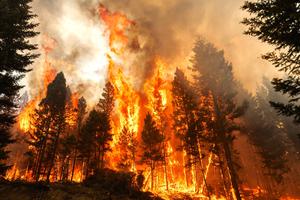Climate change may be, by far, the leading driver of this summer’s stifling heat, but three other factors are helping push the mercury to new extremes.
The first is the 2022 eruption of Hunga Tonga-Hunga Ha-apai, an underwater volcano near Tonga, in the South Pacific. Typically, volcanic eruptions unleash sulfur-based aerosols, which block sunlight, cooling the planet, but the Hunga Tonga produced only a small amount of aerosols. At the same time, it vaporized a large volume of seawater. That water vapor, a heat-trapping gas, could raise global temperatures by 0.06 degrees F (more than 0.03 degrees C) over the next several years, according to a recent study.
The second factor is a change in the amount of energy radiating from the sun, which rises and falls ever so slightly every 11 years. At the high point in this cycle, a surge in solar energy warms the Earth by around 0.09 degrees F (0.05 degrees C). The sun is now ramping up to its next peak, expected in 2025.
The third factor is that the Pacific Ocean is heading into its warmer El Niño phase, when balmy ocean waters radiate heat into the air. The last strong El Niño raised global temperatures by 0.25 degrees F (0.14 degrees C).
Climate change still looms much larger than any of these factors. Humans have warmed the Earth by 2.2 degrees F (1.2 degrees C) since the preindustrial era, loading the dice for oppressively hot weather. Scientists say that climate change made the recent searing heat wave in China 50 times more likely, while it made concurrent heat waves in Europe and North America at least 1,000 times more likely. This month is on track to be the hottest ever recorded, with unprecedented heat signaling that “the era of global boiling has arrived,” said UN Secretary-General António Guterres.
And temperatures continue to creep up. “If a strong El Niño develops over the next year, combined with the solar maximum and the effects of the Hunga Tonga-Hunga Ha’apai eruption, Earth’s temperatures would likely soar to uncharted highs,” Michael Wysession, an earth scientist at Washington University, wrote in The Conversation. “According to climate modeling, this would likely mean even more heat waves, forest fires, flash floods, and other extreme weather events.”
ALSO ON YALE E360
Paris When It Sizzles: The City of Light Aims to Get Smart on Heat




